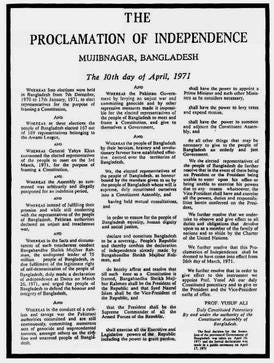The constitutional significance of the Proclamation of Independence
The Proclamation of Independence was the first constitutional document of Bangladesh. It has been described as “the genesis of [the] Bangladesh Constitution”. It was issued on 10 April 1971 and made public on 17 April during the oath-taking ceremony of the Mujibnagar Government. Its significance in the Bangladeshi context is comparable to the Articles of Confederation in the American context. Both documents provided the initial framework of government in emerging states during wartime amid a struggle for independence.
It can also be compared with the Indian Independence Act 1947. Unlike the Indian Independence Act, the Bangladeshi proclamation was an ‘autochthonous’ document. Barrister Amir-ul-Islam played a key role in drafting the proclamation. He was later a key member of the post-liberation Constitution Drafting Committee.
The proclamation began by referring to the 1970 general election, in which the Awami League secured 167 out of 169 East Pakistani seats in the Pakistan National Assembly. It describes the election of 1970 as one in which the objective was “to elect representatives for the purpose of framing a Constitution”.
It refers to the scheduled date for convening the newly elected assembly on 3 March, which was “arbitrarily and illegally postponed for an indefinite period”. In reference to Operation Searchlight launched on the night of 25 March, the proclamation describes Pakistan’s military operations as an “unjust and treacherous war”.
It refers to the declaration of independence by Bangabandhu Sheikh Mujibur Rahman on 26 March 1971. It calls on the people of Bangladesh to defend, preserve and uphold this independence. The proclamation accuses Pakistan of waging “a ruthless and savage war”, including genocide against the unarmed people of Bangladesh.
As Pakistan “made it impossible for the elected representatives of the people of Bangladesh to meet and frame a Constitution, and give to themselves a Government”, the proclamation converted elected representatives into members of a Constituent Assembly of Bangladesh. It pronounces “equality, human dignity and social justice” as the principles of governance for the people of Bangladesh. It also renames East Pakistan as the sovereign People’s Republic of Bangladesh.
It laid down a presidential system of government during wartime. The president was given the power to appoint a prime minister, collect taxes, enact laws, and convene and dissolve the Constituent Assembly. The proclamation also referred to the United Nations Charter and the duties and obligations that fall upon the new born state as a member of the family of nations.
Bangladesh adopted the parliamentary system in 1972. The Proclamation of Independence was the interim constitution and basic law of Bangladesh until December 1972, when the Constitution of Bangladesh was enacted.


